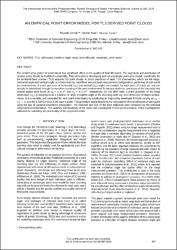An emprical point error model for TLS derived point clouds
Künye
Özendi, M., Akça, M. D. & Topan, H. (2016). An emprical point error model for TLS derived point clouds. Paper presented at the International Archives of the Photogrammetry, Remote Sensing and Spatial Information Sciences, 41(B5), 557-563. doi:10.5194/isprsarchives-XLI-B5-557-2016Özet
The random error pattern of point clouds has significant effect on the quality of final 3D model. The magnitude and distribution of random errors should be modelled numerically. This work aims at developing such an anisotropic point error model, specifically for the terrestrial laser scanner (TLS) acquired 3D point clouds. A priori precisions of basic TLS observations, which are the range, horizontal angle and vertical angle, are determined by predefined and practical measurement configurations, performed at real-world test environments. A priori precision of horizontal (σθ) and vertical (σα) angles are constant for each point of a data set, and can directly be determined through the repetitive scanning of the same environment. In our practical tests, precisions of the horizontal and vertical angles were found as σθ=±36.6 and σα=±17.8, respectively. On the other hand, a priori precision of the range observation (σρ) is assumed to be a function of range, incidence angle of the incoming laser ray, and reflectivity of object surface. Hence, it is a variable, and computed for each point individually by employing an empirically developed formula varying as σρ=±2a'12 mm for a FARO Focus X330 laser scanner. This procedure was followed by the computation of error ellipsoids of each point using the law of variance-covariance propagation. The direction and size of the error ellipsoids were computed by the principal components transformation. The usability and feasibility of the model was investigated in real world scenarios. These investigations validated the suitability and practicality of the proposed method.
Kaynak
International Archives of the Photogrammetry, Remote Sensing and Spatial Information SciencesCilt
41Sayı
B5İlgili Öğeler
Başlık, yazar, küratör ve konuya göre gösterilen ilgili öğeler.
-
A point cloud filtering method based on anisotropic error model
Özendi, Mustafa; Akça, Devrim; Topan, Hüseyin (John Wiley and Sons Inc, 2023-12)Many modelling applications require 3D meshes that should be generated from filtered/cleaned point clouds. This paper proposes a methodology for filtering of terrestrial laser scanner (TLS)-derived point clouds, consisting ... -
EEG signal compression based on classified signature and envelope vector sets
Gürkan, Hakan; Güz, Ümit; Yarman, Bekir Sıddık Binboğa (IEEE Computer Society, 2007)In this paper, a novel method to compress ElectroEncephaloGram (EEG) Signal is proposed. The proposed method is based on the generation Classified Signature and Envelope Vector Sets (CSEVS) by using an effective k-means ... -
Elektroensefalogram (EEG) işaretlerinin sıkıştırılmasında özgün bir yaklaşım
Gürkan, Hakan; Güz, Ümit; Yarman, Bekir Sıddık Binboğa (IEEE, 2008)Bu çalışmada, Elektroensefalogram(EEG) işaretlerinin yeniden oluşturulmasına yönelik olarak yeni bir yöntem sunulmaktadır. Sunulan yöntem, etkin bir k-ortalamalı sınıflandırma algoritması kullanılarak Sınıflandırılmış Temel ...


















